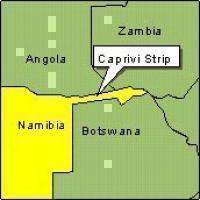







|
News and Information
Caprivi the poorest region in Namibia, says report
| July 21, 2006 |
 Caprivi the poorest region in Namibia, says report Caprivi the poorest region in Namibia, says report
BRIGITTE WEIDLICH
POOR water supply, an underdeveloped road network, lack of modern infrastructure and its remoteness characterise the Caprivi Region, a new assessment of the area reveals.
The Caprivi Poverty Profile was launched at Katima Mulilo recently.
It is the third regional profile after Ohangwena and Omaheke.
Profiles on the other 10 regions will follow soon.
The Poverty Profile Assessment (PPA) is a policy research method that involves poor people analysing poverty from their own perspectives and it provides a clearer insight on key issues in the effort to reduce poverty.
It was compiled by the National Planning Commission (NPC) with the help of the United Nations Development Programme (UNDP), while the assessment was conducted by the local company Urban Dynamics.
About 80 000 people live in the Caprivi, which is dominated by subsistence farming, and 72 per cent live in rural areas.
The land gives them almost everything necessary for survival.
If rainfall is low, the people suffer; if the rains are good, they have relatively good food security, the report noted.
The assessment team visited communities at Choto, a suburb of Katima Mulilo, and the villages Ikaba, Mazoba, Sangwali, Zilitene and Omega 3.
"Caprivi is the poorest region in the country with a Human Poverty Index (HPI) of 36 per cent compared to an overall HPI average of 24.7 per cent for Namibia," the report said.
People who do not have oxen to plough the land do piecework jobs for those who own oxen in order to borrow oxen from them.
This leads to late planting, however, as they can only get oxen once all the fields of the richer people, who own oxen, are ploughed.
"As a result, the poor almost always plant too late, their crops mature too late and they are often unable to harvest."
In some areas the annual floods - which arrive in the winter months - would come before crops were ready for harvesting.
The communities also made it clear to the assessment team that rainfall patterns had shifted over the years and were coming later.
Consequently, they have to cultivate their fields later than usual.
Children have far to walk to school and as a result a unique system of hostels has developed.
Parents erect huts and tents for their children in those villages where schools are situated and the children live there by themselves from Monday to Friday.
They bring their own food and must collect firewood and cook their own food after school.
They are not supervised and conditions for studying are poor.
The Omega 3 community consists mainly of Khwe-speaking people of San origin.
They may not keep livestock, as they live in the Bwabwata game park.
They may not hunt and since they lack ploughs and other agricultural equipment, they collect wild fruit, often penetrating into southern Angola.
HIV-AIDS was seen as the most serious problem in the communities visited by the assessment team, but they observed that "it is almost as if people are in denial about it".
One community categorically stated that they did not believe in the existence of AIDS, despite a prevalence rate of over 40 per cent in the Caprivi Region.
Others held the opinion that "nothing could be done about AIDS."
Another observation made was that villagers in the Caprivi had a policy of not divulging deaths related to HIV-AIDS.
"This practice strips the fight against the disease of its urgency.
Serious consideration should be given to release to the deceased's family at least the true cause of the death.
"This news will at least shock them into action and make them realise AIDS is real and it will filter down to other community members," the report recommended.
|
Source: www.namibian.com.na |
| http://www.namibian.com.na/2006/July/national/063600C422.html |
|
| Support Caprivi Freedom |
Fill out the form below to become a member of this site and receive our regular newsletter.
|

|

